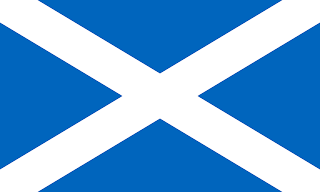This was a relief as I was beginning to doubt that I’d ever be able to prove my father’s claim that we had Scottish heritage. As explained in an earlier post, the Y chromosome is passed down the male line, which means that my father’s father’s branch of the family is Scottish. Not only do the ethnicity estimates show a significant amount of Scottish DNA in my genes, but the Y-DNA matches support that.
The next step is to find an ancestor who was born in Scotland. That, however, may be difficult. Since the Lowe name does not appear in the trees of the Y-DNA matches. This may sound unusual, but it happens a lot. Why? There are several reasons. The first is that not nearly as many people have done Y-DNA tests because they are expensive. So the database is small, limiting the odds of finding significant matches. In fact, at the 67-marker level (the highest on my brother's test), the closest match is a 4, which means we are essentially four generations apart. So the lack of matches to anyone named Lowe could be a result of a lack of data.
This lack of data is compounded by my tree containing few boys on that particular branch. Remember that Y-DNA is only passed on to males. Here's the situation. The earliest Lowe in have is John Lowe, my 3x great-grandfather, who was probably born in the late 1700s. I know nothing about John Lowe other than his name appears on the baptism and marriage records for my great-great grandfather, Henry Lowe. Henry had five sons. My great-grandfather, Henry Joseph, was the oldest of the boys. But HJ had only one son who lived to adulthood. The next boy had a daughter but no sons. I know nothing about the next boy. The fourth son had three boys. The youngest boy had five sons. That's only 9 males in an entire generation of the family, which is low for the 1800s. To know how many are in the following generation would take more research time than I have right now, but I know that in my branch, there were three sons and in the next generation there were four boys in total. Those four are the only members of my generation who could do a Y-DNA test, and two of them have already died. If the statistics are similar for the other branches of the family, there may be few potential DNA donors.
But a lack of data might not be the only reason. A parental event causing a surname diversion could also be an explanation. But when and where that happened could be a complicated puzzle to solve.
Since many of the Y-DNA matches had no trees or had basic pedigrees, one suggestion was to research the family trees of the closest Y-DNA matches to see if the name Lowe appears in the same tree with the other surname. Ideally, there would be a second marriage of the parent of a boy to someone named Lowe. But the first attempts at applying that strategy added even more confusion. Apparently the name Lowe was pretty common in Scotland and there seems to be at least one Lowe in the tree of each match I look at — usually a woman marrying into the family — not out of it. Since Y-DNA is not passed to women, these female Lowes could not be related, at least not in the way I need.
And so, the search continues.





No comments:
Post a Comment
To prevent spam, your comment must be approved before it appears. Thank-you for your patience.